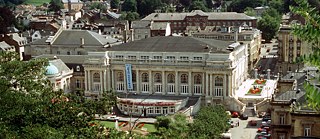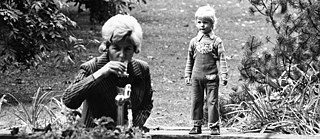Spa towns
Some liked it hot

Even the ancient Romans placed their trust in the healing powers of water, and spas would latest establish a firm foothold throughout Europe. The well-heeled travelled to England, Germany, and the Czech Republic to “take the waters”. Spa in Belgium was also a popular resort town, and enthusiastic British tourists imported its name into English, where it has become synonymous with hot springs and mineral baths.
By Sarah Klein
-

Perhaps better known today as the ‘wellness centres’ hotels advertise to attract guests, the term ‘spa’ originally referred to a town with mineral water or hot springs. In German, the names of these spa towns often begin with ‘bad’, the German word for bath, a reminder of their role in promoting health thanks to their climate, minerals in the soil, or hot springs.
-

The people of the ancient world were well-versed in the benefits of healing waters: the Romans, Greeks, Egyptians and Babylonians all had deeply rooted bathing traditions. The Romans built thermal baths throughout their empire. The ruins of these Roman thermea have been found as far afield as modern Libya. Along with Antonine Baths in Carthage, the thermal baths built by Hadrian in Leptis Magna (photo) are the largest Roman thermea on African soil.
-

The Baths of Carcalla was one of ancient Rome’s largest public baths. Completed with a number of additions and decorations in 235, it offered an ancient wellness program to between 6,000 and 8,000 people a day. Along with hot and cold pools, the baths offered massages, manicures, hair styling, a wide variety of food and beverage stalls, and even a library.
-

Many of the spa towns and hot springs we know today can trace their historical roots back to the Romans. Like the town of Bath in English Somerset, famed throughout the world for its Roman bath complex. When the Anglo-Saxons conquered the town in the 5th century, they baptized it “Hat Batha” (“hot baths”), from which the modern name Bath derives. In the 16th and 17th centuries, this World Cultural Heritage Site topped the list of hot spas to visit and wasn’t outpaced by other spas until the 19th century.
-

In the 18th century, the Kaiserbad Therme in Aachen, one of the great fashion spas par excellence of its time, was the place to be for anyone who was anyone. Over the centuries, the city has boasted many “imperial spas”, as new bathing establishments sprung up around the 52-degree-Celsius spring. Not surprisingly, the first bath buildings here date back to the Romans as well.
-

As the 19th century dawned, taking the waters at a spa became so popular that elegant baths were built throughout Europe and competed for custom. Three spas in what is the Czech Republic today, Karlovy Vary (photo), Mariánské Lázně, and Františkovy Lázně, enjoyed particular favour among health tourists. The West Bohemian Spa Triangle is still famous today for its hot mineral springs that can get up to 73 degrees Celsius.
-

In the 19th century, the Belgian town of Spa also attracted the crème de la crème of society. Noblemen and industrialists from all over Europe and Russia travelled to the place where monarchs were known to meet. As a result, Spa soon earned a name for itself as the “Café de l’Europe”. 16th century British tourists imported the word “spa” into the English language, where it has become synonymous with any oasis that promotes health and well-being.
-

The spa town of Baden-Baden in the Black Forest advertised itself as the “Summer Capital of Europe”. Such nicknames, such as “Café de l’Europe” for Spa in Belgium – were adopted by towns to draw attention to the European significance of their spa. Baden-Baden is another town built around a mineral spring that can trace its origins back to the Romans, and was returned to much of its former glory during the economic miracle of the 1950s and 1960s. The Shah of Iran Reza Pahlavi and his wife Queen Soraya were honoured guests in 1955. The photo shows Spa guests taking a drinking cure in Baden-Baden.
-

The Széchenyi Thermal Bath in Hungary’s capital, Budapest, is the largest bath complex in Europe in terms of sheer square metres. It opened in 1881 as the 19th century was drawing to a close. Drilling down the 970 metres to access the thermal spring was an impressive engineering feat which paid off, and Széchenyi Thermal Bath was granted the “therapeutic bath” title in 1904. Today the bath complex has been expanded to include a public swimming pool, a beach, and an outpatient clinic.
-

There is currently a push underway to have Europe’s spa heritage, the rise of the spa town and the resulting tourism, recognised as official World Cultural Heritage. In 2010, a group of historic spa towns came together under the “The Great Spas of Europe” title, including, amongst others, Baden-Baden (Germany), Baden (Austria), Vichy (France), Spa (Belgium), Bath (Great Britain), and Františkovy Lázně, Mariánské Lázně, and Karlovy Vary (Czech Republic). The group plans to submit an application to UNESCO in 2019. By the way, the name of Caracalla Spa (photo) in Baden-Baden, Germany was inspired by the Romans.
-

The Terme Tettuccio in Montecatini in Italy (photo) is also included in the list of „Great Spas of Europa“. This kind of transnational serial application is tremendously complicated and unique in the history of the UNESCO World Cultural Heritage process. The number of participating sites has dropped over time, as all have to meet all the requirements for a World Heritage site individually. It remains to be seen whether this bid for protected status succeeds.
A contribution from Germany
with relation to the Czech Republic, Belgium,
England, Hungary